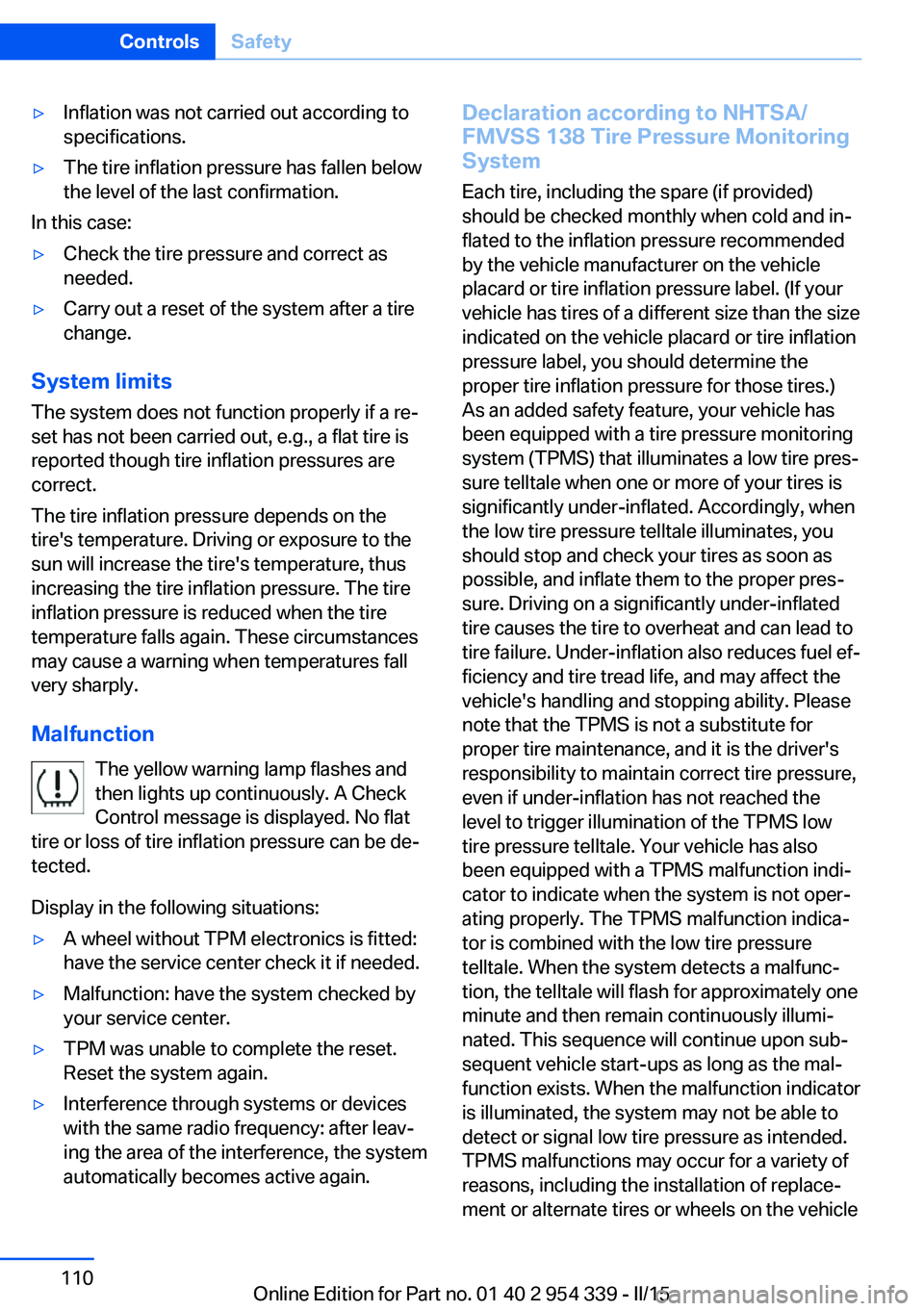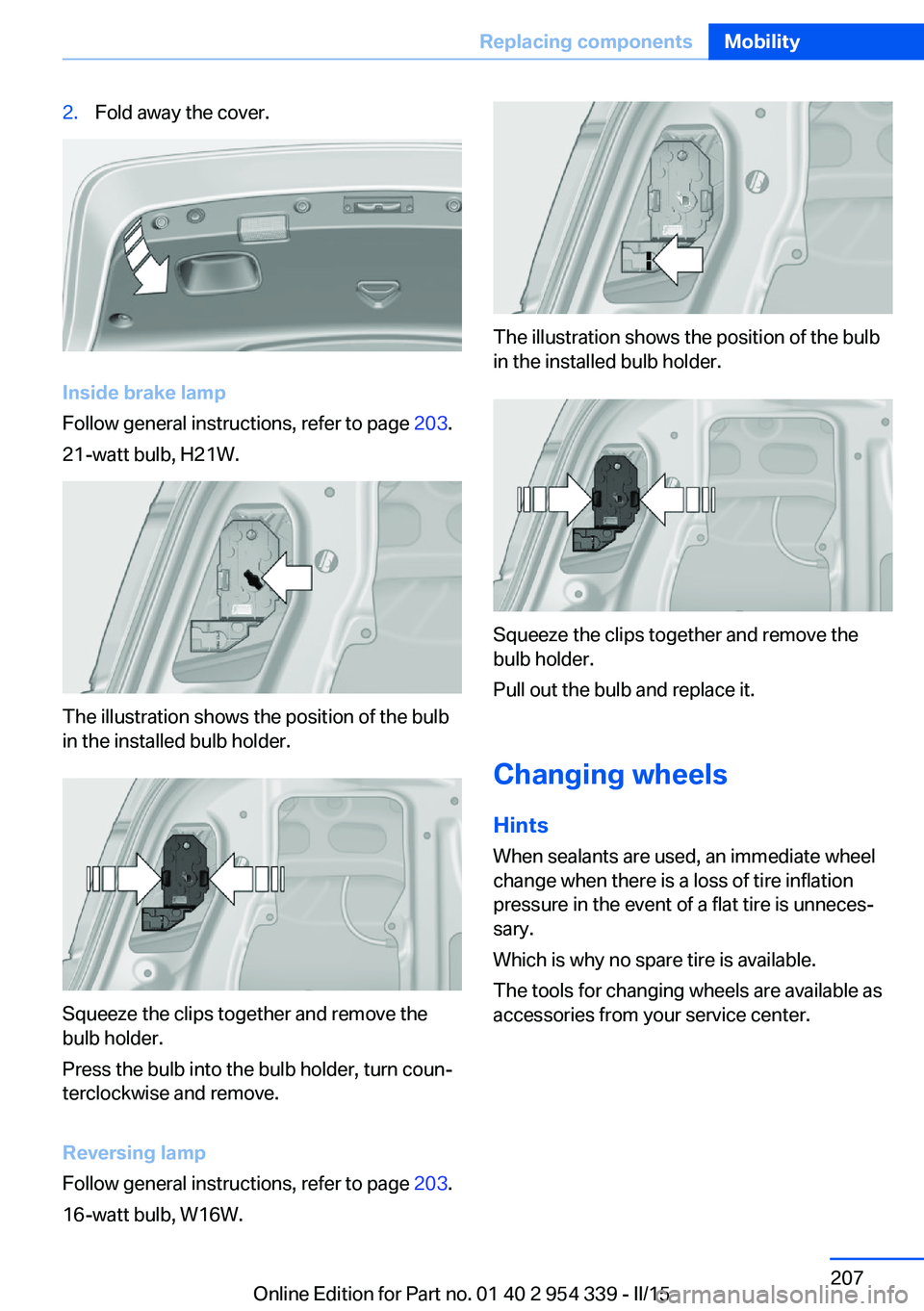2015 BMW M5 SEDAN spare wheel
[x] Cancel search: spare wheelPage 114 of 239

▷Inflation was not carried out according to
specifications.▷The tire inflation pressure has fallen below
the level of the last confirmation.
In this case:
▷Check the tire pressure and correct as
needed.▷Carry out a reset of the system after a tire
change.
System limits
The system does not function properly if a re‐
set has not been carried out, e.g., a flat tire is
reported though tire inflation pressures are
correct.
The tire inflation pressure depends on the
tire's temperature. Driving or exposure to the
sun will increase the tire's temperature, thus
increasing the tire inflation pressure. The tire
inflation pressure is reduced when the tire
temperature falls again. These circumstances
may cause a warning when temperatures fall
very sharply.
Malfunction The yellow warning lamp flashes and
then lights up continuously. A Check
Control message is displayed. No flat
tire or loss of tire inflation pressure can be de‐
tected.
Display in the following situations:
▷A wheel without TPM electronics is fitted:
have the service center check it if needed.▷Malfunction: have the system checked by
your service center.▷TPM was unable to complete the reset.
Reset the system again.▷Interference through systems or devices
with the same radio frequency: after leav‐
ing the area of the interference, the system
automatically becomes active again.Declaration according to NHTSA/
FMVSS 138 Tire Pressure Monitoring
System
Each tire, including the spare (if provided)
should be checked monthly when cold and in‐
flated to the inflation pressure recommended
by the vehicle manufacturer on the vehicle
placard or tire inflation pressure label. (If your
vehicle has tires of a different size than the size
indicated on the vehicle placard or tire inflation
pressure label, you should determine the
proper tire inflation pressure for those tires.)
As an added safety feature, your vehicle has
been equipped with a tire pressure monitoring
system (TPMS) that illuminates a low tire pres‐
sure telltale when one or more of your tires is
significantly under-inflated. Accordingly, when
the low tire pressure telltale illuminates, you
should stop and check your tires as soon as
possible, and inflate them to the proper pres‐
sure. Driving on a significantly under-inflated
tire causes the tire to overheat and can lead to
tire failure. Under-inflation also reduces fuel ef‐
ficiency and tire tread life, and may affect the
vehicle's handling and stopping ability. Please
note that the TPMS is not a substitute for
proper tire maintenance, and it is the driver's
responsibility to maintain correct tire pressure,
even if under-inflation has not reached the
level to trigger illumination of the TPMS low
tire pressure telltale. Your vehicle has also
been equipped with a TPMS malfunction indi‐
cator to indicate when the system is not oper‐
ating properly. The TPMS malfunction indica‐
tor is combined with the low tire pressure
telltale. When the system detects a malfunc‐
tion, the telltale will flash for approximately one
minute and then remain continuously illumi‐
nated. This sequence will continue upon sub‐
sequent vehicle start-ups as long as the mal‐
function exists. When the malfunction indicator
is illuminated, the system may not be able to
detect or signal low tire pressure as intended.
TPMS malfunctions may occur for a variety of
reasons, including the installation of replace‐
ment or alternate tires or wheels on the vehicleSeite 110ControlsSafety110
Online Edition for Part no. 01 40 2 954 339 - II/15
Page 211 of 239

2.Fold away the cover.
Inside brake lamp
Follow general instructions, refer to page 203.
21-watt bulb, H21W.
The illustration shows the position of the bulb
in the installed bulb holder.
Squeeze the clips together and remove the
bulb holder.
Press the bulb into the bulb holder, turn coun‐
terclockwise and remove.
Reversing lamp
Follow general instructions, refer to page 203.
16-watt bulb, W16W.
The illustration shows the position of the bulb
in the installed bulb holder.
Squeeze the clips together and remove the
bulb holder.
Pull out the bulb and replace it.
Changing wheels Hints
When sealants are used, an immediate wheel
change when there is a loss of tire inflation
pressure in the event of a flat tire is unneces‐
sary.
Which is why no spare tire is available.
The tools for changing wheels are available as
accessories from your service center.
Seite 207Replacing componentsMobility207
Online Edition for Part no. 01 40 2 954 339 - II/15
Page 235 of 239

Seat, mirror, and steeringwheel memory 59
Seats 53
Seat ventilation, front 56
Selection list in instrument cluster 93
Selector lever 77
Selector lever position 77
Sensors, care 219
Sequential mode 78
Service and warranty 8
Service requirements, Condi‐ tion Based Service
CBS 201
Service requirements, dis‐ play 90
Services, ConnectedDrive
Servotronic 131
SET button, see Cruise con‐ trol 133
Settings, locking/unlock‐ ing 46
Settings, M Drive 127
Settings on Control Dis‐ play 96
Settings, storing for seat, mir‐ rors, steering wheel 59
Shift point indicator 99
Shoulder support 55
Side airbags 105
Side View 140
Signaling, horn 14
Signals when unlocking 46
Sitting safely 53
Size 222
Ski bag 158
Slide/tilt glass roof 50
Smallest turning radius 222
Smoker's package 153
Snow chains 194
Socket 155
Socket, OBD Onboard Diag‐ nostics 202
SOS button 210
Spare fuse 209
Speaker lighting 104 Specified engine oil
types 199
Speed, average 94
Speed limit detection, on- board computer 95
Speed limiter, display 92
Speed Limit Information 92
Speed warning 95
Split screen 23
Sport displays, torque dis‐ play, performance dis‐
play 95
Stability control systems 127
Standard view, head-up dis‐ play 98
Start/stop, automatic func‐ tion 70
Start/Stop button 68
Start function during malfunc‐ tion 35
Starting the engine 69
Status control display, tires 109
Status information, iDrive 22
Status of Owner's Manual 7
Steering assistance 131
Steering wheel, adjusting 62
Steering wheel heating 63
Steering wheel memory 59
Stopping the engine 69
Storage compartment, re‐ mote control 163
Storage compartments 160
Storage compartments, loca‐ tions 160
Storage, tires 191
Storing the vehicle 219
Suitable engine oils 199
Summer tires, tread 189
Sun visor 153
Supplementary text mes‐ sage 87
Surround View 137
Switch-on times, parked-car ventilation 150
Switch, refer to Cockpit 14 Symbols 6
Symbols in the status field 22
SYNC program, automatic cli‐ mate control 146
System states of dynamic driving 90
T
Tachometer 87
Tail and brake lights 206
Tail lights 206
Tail lights, bulb replace‐ ment 206
Technical changes, refer to Safety 7
Technical data 222
Technology, BMW M 168
Telephone, see user's manual for Navigation, Entertain‐
ment and Communication
Temperature, automatic cli‐ mate control 145
Temperature display for ex‐ ternal temperature 88
Temperature, engine oil 87
Terminal, starting aid 212
Text message, supplemen‐ tary 87
Theft alarm system, refer to Alarm system 47
Thermal camera, see Night Vision 118
Through-loading system 156
Tilt alarm sensor 47
Time of arrival 94
Tire damage 189
Tire identification marks 187
Tire inflation pressure 186
Tire inflation pressure moni‐ tor, refer to FTM 111
Tire Pressure Monitor TPM 108
Tires, changing 190
Tire sealant 191 Seite 231Everything from A to ZReference231
Online Edition for Part no. 01 40 2 954 339 - II/15